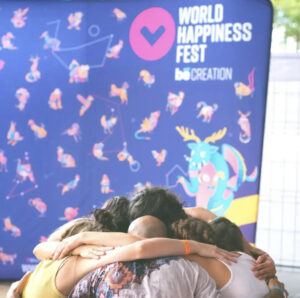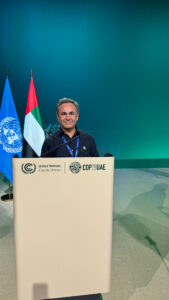
World Happiness Foundation Position on SDG 17: Global Unity and Collective Action
Fostering a Global Family United by Abundance and Purpose. At

Oceans cover over 70% of our planet and form the cradle of life on Earth. They provide food and livelihoods for more than 3 billion people and even carry over 80% of global trade by volumesdgs.un.orgsdgs.un.org. The ocean economy is enormous – generating around $1.5 trillion annually and projected to double to $3 trillion by 2030, supporting well over 100 million jobs worldwide. Yet our blue planet is at a crossroads. Alarming trends – declining fish stocks, pollution, ocean warming, acidification, and habitat destruction – are pushing marine ecosystems to the brinksdgs.un.org. Over 37% of global fish stocks are now overfished (up from 35% just a few years prior)sdgs.un.org, undermining the food security of countless coastal communities. Every year, an estimated 11 million metric tons of plastic flood into the oceans on top of the ~200 million tons already circulating, choking wildlife and forming toxic garbage patches. Meanwhile, rising carbon emissions drive ocean acidification and ever more extreme marine heatwaves – in 2023, record-breaking heat events impacted 96% of the ocean’s surface, lasting four times longer than normal. Coral reefs are bleaching, fisheries are collapsing, and coastal livelihoods are increasingly in peril. In short, SDG 14: Life Below Water – to conserve and sustainably use our oceans – is in urgent need of acceleration.
For the World Happiness Foundation (WHF), the health of our oceans is not a niche environmental issue; it lies at the heart of human well-being and our shared future. We view the oceans as sacred sources of life – the blue lungs and arteries of our planet that sustain us all. Our commitment to Happytalism (a paradigm of abundance, interdependence, and well-being) compels us to move beyond a mindset of exploitation or scarcity when it comes to the seas. Instead, we embrace an ethos of abundance and reverence, recognizing that a healthy ocean is non-negotiable for a happy, sustainable world. As we prepare to share our vision at upcoming global forums, we stand with the United Nations and communities worldwide in declaring that the era of treating oceans as an infinite dumping ground or an inexhaustible storehouse must end. It is time to reimagine SDG 14 from the ground up – not as a mere mandate to minimize harm, but as a joyful duty to maximize flourishing in our marine ecosystems. In this position paper, we outline our vision for “Flourishing Oceans & Marine Unity,” reframing SDG 14 with an abundance mindset and charting a path toward a future where humanity and the oceans thrive together in harmony.
SDG 14 (Life Below Water) calls on us to conserve and sustainably use the oceans, seas, and marine resources. The World Happiness Foundation wholeheartedly supports these targets – and we believe we can amplify them by reframing SDG 14 as “Flourishing Oceans & Marine Unity.” This expanded vision treats the oceans not as resources to manage from a distance, but as living relatives deserving our respect and care. To us, flourishing oceans means seas teeming with life, from vibrant coral reefs and seagrass meadows to abundant fish populations and recovered whale pods. It means marine ecosystems that are thriving, resilient, and regenerative, rather than merely surviving our impact. Marine unity, meanwhile, speaks to a deep recognition of interdependence: the understanding that humanity is one with the ocean and all its creatures. In practical terms, this vision demands that we end marine pollution and overfishing, protect critical habitats, and elevate ocean health to a sacred priority. We must replace exploitation with stewardship rooted in love and awe for marine life. Indigenous cultures have long treated oceans and waterways as sacred; our modern society can learn from this wisdom by fostering an ethic of reverence in all ocean activities – whether it’s fishing, shipping, tourism, or new ventures like deep-sea mining (which must be approached with extreme caution, if at all).
Crucially, viewing the ocean through an abundance mindset flips the script on conservation. Instead of focusing on what we must restrain or take less of, we focus on what we can restore and grow. For example, rather than accepting dwindling fish catches as a zero-sum inevitability, an abundance approach invests in letting fish populations rebound to abundance. Marine protected areas (MPAs) are a cornerstone of this strategy. When given breathing room, ocean life can recover spectacularly – studies show fully protected reserves often have 7–14 times more fish than adjacent fished areas, with some species producing 100 times more offspring within these safe havens. This regenerative power of nature is the essence of abundance: it reminds us that the ocean’s capacity to heal is vast if we only give it the chance. Our reframed Goal 14 therefore emphasizes creating the conditions for oceans to heal and prosper, not just preventing their collapse. It is a positive vision: one where whales, dolphins, turtles, and coral reefs increase in number year by year; where sustainable aquaculture and fisheries provide ample nutrition without emptying the seas; and where coastal communities celebrate returning species and healthier waters. Achieving this will require infusing every policy and practice with reverence for marine life – from how we design fishing gear (e.g. using turtle-safe hooks and nets) to how we reduce shipping noise and pollution. The World Happiness Foundation calls for making ocean happiness a key metric of progress: are our oceans getting healthier each year? Is marine biodiversity increasing? These are the questions that should guide us. In an abundant world view, healthy oceans are non-negotiable – our collective prosperity and happiness depend on seas that are **alive, clean, and full of wonder.
No goal stands alone: the fate of our oceans is intimately tied to virtually every other Sustainable Development Goal. Recognizing this interdependence is central to the WHF’s approach. We cannot achieve global happiness and well-being in isolation from ocean health; a flourishing blue planet underpins a flourishing human society. Consider a few examples of how SDG 14 interlinks with other global goals:
These are just a few of many connections. Quality Education (SDG 4) is needed to raise ocean literacy and cultivate new generations of marine stewards. Industry, Innovation & Infrastructure (SDG 9) can advance cutting-edge solutions – from biodegradable plastics to AI-driven illegal fishing surveillance – that help protect marine life. Peace, Justice & Strong Institutions (SDG 16) are critical for enforcing ocean laws and resolving conflicts over marine resources peacefully. Indeed, as fish stocks decline, tensions over fishing rights have flared in various regions; nurturing an abundant ocean through cooperation can reduce such conflicts and foster peace. Ultimately, SDG 14 is a linchpin: without healthy oceans, efforts on poverty, hunger, health, climate, and peace will be undermined. Conversely, achieving “Flourishing Oceans & Marine Unity” would give a tremendous boost to all the global goals, creating a virtuous cycle of sustainability and well-being. This truth reinforces the World Happiness Foundation’s holistic mission – we cannot pursue happiness for humanity while ignoring the ocean that makes life on Earth possible. Our fate is truly intertwined with the fate of the seas.
Achieving SDG 14 will require more than technological fixes or policy tweaks – it calls for a profound mindset shift in how humanity relates to the ocean. For centuries, the dominant mindset has been one of scarcity and exploitation: we treated the ocean as a bottomless larder of fish to catch, a limitless expanse for dumping waste, and a stage for fierce competition over resources. This mentality is rooted in fear – a fear that if we don’t grab as much as possible now, someone else will, or it will be gone tomorrow. It is the mindset that led to whaling fleets driving species to near-extinction, industrial fishing fleets scouring every corner of the high seas, and nations racing to stake claims on seabed minerals. The irony is that this scarcity-driven approach creates the very scarcity it fears: by overfishing and polluting, we have made fish and clean water scarce. It’s a self-fulfilling prophecy of depletion.
The World Happiness Foundation advocates replacing this destructive cycle with an abundance mindset grounded in reverence. In practical terms, that means shifting from a paradigm of extraction to one of regeneration. We ask: How can we give back to the ocean more than we take? Rather than seeing protection measures as a loss or constraint, we see them as the path to greater abundance for all. For example, ending harmful fishing subsidies and banning destructive practices (like bottom trawling or shark finning) isn’t “holding back development” – it’s enabling oceans to rebound, which ultimately yields more fish and income in the long run. Likewise, investing in waste management and circular economy innovations on land (to stop plastics from ever reaching the sea) isn’t a burden; it’s common sense for an abundant future where our grandchildren can enjoy plastic-free beaches and seafood free of microplastics. An abundance mindset trusts that if we care for nature, nature will care for us back – a principle repeatedly proven when devastated ecosystems are given a chance to recover. We have inspiring evidence: areas once written off as “dead zones” have sprung back to life after pollution was curtailed; marine sanctuaries like Cabo Pulmo in Mexico saw fish biomass increase by over 400% after a decade of protection, turning former fishermen into proud ecotourism guides. Stories like these fuel our optimism that a different approach is not only possible but already underway in pockets around the globe.
At the heart of this new relationship is reverence – a word not often used in policy, but one we find essential. To revere the ocean is to recognize its intrinsic value beyond economic utility. It is to stand in awe of a breaching humpback whale or a swirling school of anchovies and feel a sense of kinship and responsibility. Cultivating reverence means weaving respect for marine life into our culture: in education (teaching children that a sea turtle or seahorse is as worthy of love as any land animal), in media and storytelling (celebrating ocean heroes and success stories), and in spiritual or ethical frameworks (seeing the ocean as a living entity with rights, as some nations are beginning to consider). When reverence guides us, exploitation becomes unthinkable – you do not dump toxic waste into what you hold sacred, nor do you greedily strip-mine something you deeply respect. Instead, you protect it fiercely and use its gifts wisely, with gratitude. The WHF believes this inner transformation – from viewing the ocean as a commodity to honoring it as our blue ancestor and ally – is the key to unlocking all the practical solutions. With a reverent, abundance mindset, policies like fully protecting 30% of the ocean by 2030 (“30×30”) are seen not as radical, but as necessary acts of care. Global cooperation, too, becomes easier when we all share a basic respect for the ocean that transcends borders. We are encouraged by developments such as the 2023 UN High Seas Treaty, a landmark agreement where nations came together to protect marine life in international waters. This shows a growing unity in valuing the ocean for the common good. As of mid-2025, over 50 countries have already ratified this treaty, edging it closer to entry into force – a hopeful sign that the world is ready to turn the page on the “Wild West” era of the high seas. Our position is clear: to truly achieve SDG 14, we must end the era of ocean plunder and usher in an era of ocean reverence. Every government, business, and individual has a role in this shift – whether by supporting marine conservation efforts, innovating sustainable ocean practices, or simply developing a personal relationship with the sea (even if one lives far inland, our daily choices affect the ocean through what we consume and discard). By moving from exploitation to reverence, we can ensure the ocean’s bounty is preserved and enhanced for generations to come.
Ultimately, the World Happiness Foundation’s vision for SDG 14 is one of hope, unity, and collective flourishing. We see a future in which the ocean is a source of joy, inspiration, and sustenance for all – a future where children might witness once-endangered sea turtles nesting in abundance, where coastal communities thrive on sustainable blue economies, and where global conflicts over fisheries give way to cooperative stewardship of the seas. This future is not a naïve fantasy, but a very real possibility within our grasp. The science, technology, and resources needed to heal the oceans already exist; what’s needed is the will and wisdom to use them wisely. We take inspiration from success stories: nations coming together to create vast marine reserves in the Pacific, community-led coastal restoration projects that bring mangroves and oysters back to dead estuaries, and international collaborations like the UN Decade of Ocean Science (2021–2030) galvanizing research for sustainable ocean management. Each of these is a beacon lighting the path forward.
The WHF’s commitment to Fundamental Peace – defined by freedom, consciousness, and happiness for all – extends to our relationship with the ocean. Peace in the human world goes hand in hand with peace in the natural world. When the oceans are in turmoil, humanity cannot truly be at peace. But in a world of flourishing oceans, we foresee less hunger, less conflict, and more harmony. Imagine coastal neighbors formerly at odds over fishing boundaries now collaborating through regional “marine unity pacts” that ensure fish stocks are shared and conserved fairly. Imagine youth across the world bonded by a shared mission to clean beaches and reduce plastic use, fostering a sense of global brotherhood/sisterhood. In the Happytalist paradigm, every person becomes a stakeholder in ocean health – and every positive action, no matter how small, contributes to the greater good. A beach cleanup or a petition to protect a coral reef is not just an environmental act; it is a profound statement of interdependence and love.
Our position on SDG 14 concludes with a call to embrace Happytalism for the ocean: to approach ocean conservation not with grim duty or apocalyptic fear, but with a spirit of joyful responsibility. Let us celebrate each victory – each marine species brought back from the brink, each new Marine Protected Area established, each ton of trash kept out of the waves – as evidence that our collective consciousness is rising. The ocean’s abundant beauty and power have an unparalleled ability to unite people across cultures. If we treat the seas as the shared heritage of humankind and all life, we build a foundation of trust and cooperation that benefits every global goal (echoing the intent of SDG 17: Partnerships for the Goals). In this sense, “Marine Unity” is both the goal and the means: by uniting for the ocean, we unite for our own survival and happiness.
In summary, achieving SDG 14: Flourishing Oceans & Marine Unity is essential for creating a world where well-being is shared by all. The World Happiness Foundation’s position is one of ambitious optimism: we are confident that by adopting an abundance mindset, honoring the ocean as sacred, and working together across all sectors, humanity can turn the tide from degradation to regeneration. We envision a 2030 where the oceans are on a clear path to recovery – where sustainable fisheries feed communities without emptying seas, where coral reefs show signs of regrowth, where plastic pollution is falling rapidly, and where international solidarity for the ocean is stronger than ever. In that world, both people and planet are healthier and happier. We invite governments, organizations, and individuals everywhere to join us in embracing “happytalism” for our oceans – to act not out of fear of scarcity, but out of love and belief in abundance. Together, let us ensure our oceans remain a source of wonder, life, and happiness for generations to come. The journey to flourishing oceans is a journey to a more peaceful, prosperous, and joyful world – a world we are proud to hand over to our children, glowing with the blues and greens of a living, thriving planet.
Sources:

Fostering a Global Family United by Abundance and Purpose. At

Introduction: Nature as Our Extended Family Life on land (United

Introduction: Climate Balance as the Foundation of Sustainable Happiness Climate